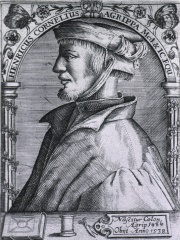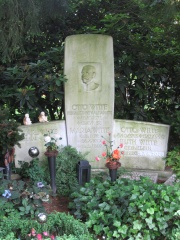

The Most Famous
OCCULTISTS from Germany
This page contains a list of the greatest German Occultists. The pantheon dataset contains 41 Occultists, 2 of which were born in Germany. This makes Germany the birth place of the 7th most number of Occultists behind Austria, and Italy.
Top 2
The following people are considered by Pantheon to be the most legendary German Occultists of all time. This list of famous German Occultists is sorted by HPI (Historical Popularity Index), a metric that aggregates information on a biography's online popularity.

1. Heinrich Cornelius Agrippa (1486 - 1535)
With an HPI of 73.53, Heinrich Cornelius Agrippa is the most famous German Occultist. His biography has been translated into 49 different languages on wikipedia.
Heinrich Cornelius Agrippa von Nettesheim (; German: [aˈgʀɪpa]; 14 September 1486 – 18 February 1535) was a German Renaissance polymath, physician, legal scholar, soldier, knight, theologian, and occult writer. Agrippa's Three Books of Occult Philosophy published in 1533 drew heavily upon Kabbalah, Hermeticism, and Neoplatonism. His book was widely influential among esotericists of the early modern period, and was condemned as heretical by the inquisitor of Cologne.

2. Otto Witte (1872 - 1958)
With an HPI of 56.01, Otto Witte is the 2nd most famous German Occultist. His biography has been translated into 16 different languages.
Otto Witte (October 16, 1872 – August 13, 1958) was a German circus acrobat and fantasist who said that he managed to be crowned King of Albania. In 1913, when Albania broke away from the Ottoman Empire, some Albanian Muslims invited Halim Eddine, a nephew of the Sultan, to come and be crowned king. Noticing his own resemblance to Halim Eddine, Witte said, he traveled to Durrës with a friend, the sword-swallower Max Schlepsig. He claimed that he had succeeded in being crowned king by the local troops on 13 August 1913. He also claimed that, over the next five days, he enjoyed a harem and declared war on Montenegro before his ruse was discovered. His claims also include that he took a substantial portion of the kingdom's treasury, and along with Schlepsig he managed to escape the palace with the aid of the harem, and eventually made their way out of the country. Most parts of his story were found to be impossible. There was no Halim Eddine and the Sultan Abdul Hamid II's son Burhan Eddine, who was offered the throne in 1914, never came; he may be the model for this story. Originally he claimed this escapade happened in February 1913, when Albania was still under Serbian occupation, so he changed the date to August 1913. There is no local evidence to support his claims. Nevertheless, he became famous in Germany for his public appearance. The Berlin police later allowed his official identity card to bear the artistic pseudonym ehemaliger König von Albanien ("former King of Albania"). For the rest of his life he insisted on being greeted with that title, and it was put on his tombstone at Ohlsdorf Cemetery, Hamburg (Parzelle Q 9, 430–433). He may have suffered from pseudologia fantastica; for example, he claimed to have founded a political party. He said he was a candidate for the German presidency in 1925, gaining 25,000 to 230,000 votes in the first round but resigning in favour of Paul von Hindenburg. The voting records do not support this either. Interest in Albania was high in the German-speaking world because the Great Powers had chosen a German prince to sit on the throne. William of Wied was offered the throne in 1913 and reigned for six months in 1914. The similarity in name between Wied and Witte may have inspired Witte to make up the story.
People
Pantheon has 2 people classified as German occultists born between 1486 and 1872. Of these 2, none of them are still alive today. The most famous deceased German occultists include Heinrich Cornelius Agrippa, and Otto Witte.

